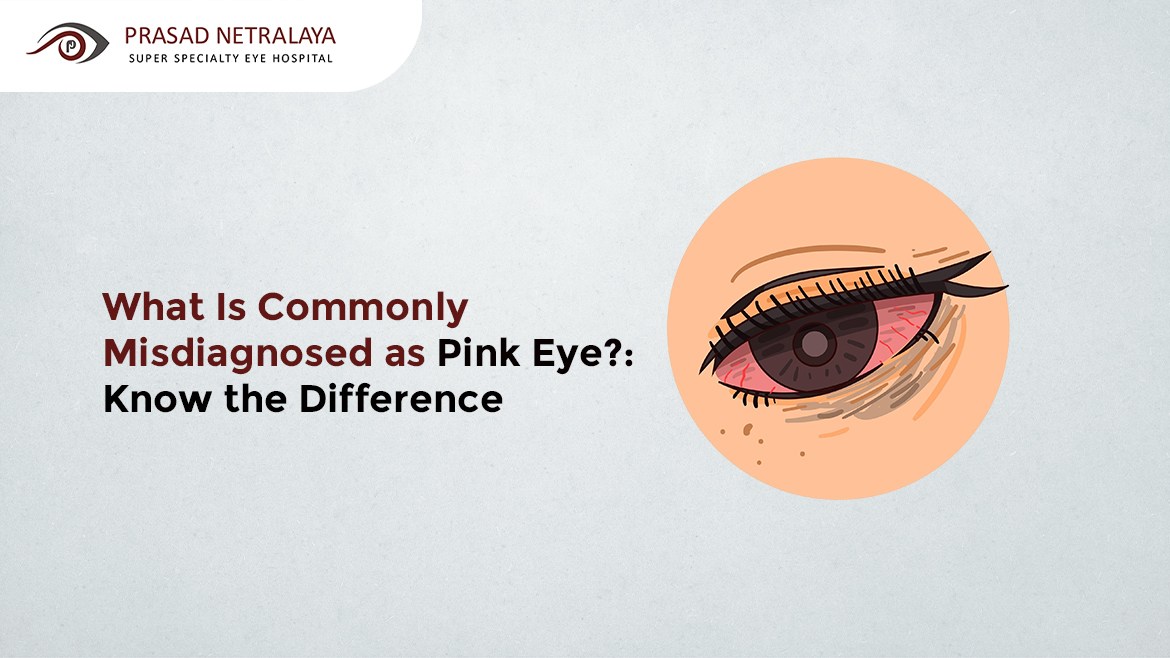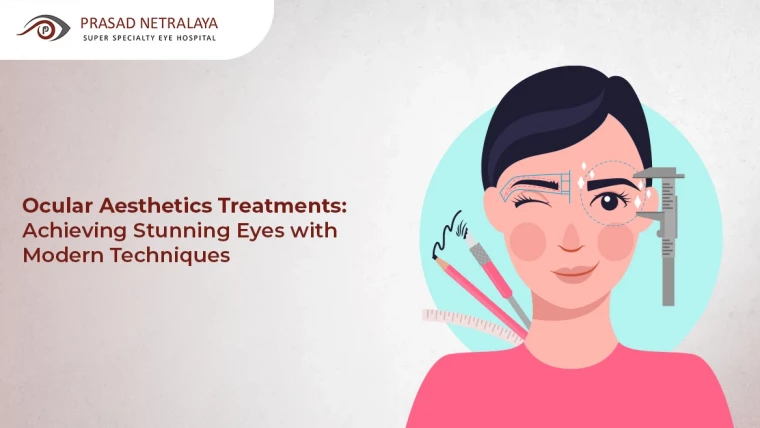How often do we experience red, itchy and watery eyes and end up diagnosing it as pink eye or conjunctivitis? Almost all the time right? Be careful because it could always be something serious.
In fact, many other eye conditions can mimic the symptoms of conjunctivitis, leading to misdiagnosis and ineffective treatments.
To save you from the adverse effects of mistaking your eye condition for pink eye, we’re here with a comprehensive blog that helps you know the difference and get the right treatment accordingly!
What is Pink Eye?
Pink eye, or conjunctivitis, is a common eye condition that causes inflammation of the conjunctiva, the thin membrane covering the white part of the eye and the inside of the eyelids.
Table of Contents
What are the symptoms of Pink Eye?
Alt text: Pink Eye
The symptoms include:
- Redness
- Grittiness or the sensation of something being stuck in your eye
- Itchiness
- Burning
- Swollen eyelids
- Wateriness or discharge
- Blurry vision
- Sensitivity to light
- Mild pain
However, there are several eye conditions with similar symptoms, which may put you in a state of confusion. Understanding these differences is crucial for seeking the correct treatment.
So let us quickly walk you through all the possible eye infections that closely resemble Pink Eye:
What is commonly misdiagnosed as Pink Eye?
- Hordeolum (Stye)
A Stye forms along the edge of the eyelid, though it can sometimes appear inside the eyelid. Its symptoms are very much like that of a pink eye, they are characterized by a red, painful bump resembling a pimple and often accompanied by eyelid swelling.
Treatment: To speed up recovery, you should consider applying a warm compress to the affected area. However, if the stye doesn’t improve or tends to worsen, consult a healthcare professional for possible antibiotic treatment.
- Blepharitis
Blepharitis is an inflammation of the eyelid, that leads to swelling, dryness, and foamy tears. Unlike pink eye, it is associated with eyelid discomfort and dryness. Even then, people try to get it treated with the medicine that cures pink eye.
Treatment: Regularly clean your eyelids with a gentle eyelid scrub. Using warm compresses can also help ease symptoms and promote healing. If that doesn’t work either, take your ophthalmologist’s advice and consume antibiotics and steroid eye drops.
- Keratitis
Keratitis is the condition that involves inflammation of the cornea, causing symptoms similar to pink eye. However, it may be more painful compared to pink eye.
Treatment: Make sure to use artificial tears to keep the eye lubricated and reduce any kind of discomfort. However artificial tears may not work in the long run if the keratitis is due to an infection. In such a case, use oral antibiotics or antibiotic eye drops after consulting your eye doctor.
- Iritis or Uveitis
Uveitis involves inflammation within the eye, which can lead to floaters or severe light sensitivity. Iritis is the type of uveitis that specifically affects the front of the eye.
Treatment: If Uveitis gets severe, it can potentially lead to vision loss, which is why it’s necessary to seek prompt medical attention as uveitis often requires steroid implants in your eye or steroid eye drops.
- Glaucoma
Glaucoma is a degenerative disease (i.e., gets gradually worse as time passes by). This may cause damage to the optic nerve, typically without immediate symptoms. Advanced stages may even lead to vision issues. Stay cautious and seek immediate medical attention without neglecting such issues.
Treatment: Regular eye exams is needed for early detection of the condition. If diagnosed, make sure to follow your doctor’s advice, which may include prescription eye drops or surgical options to control intraocular pressure (i.e. pressure inside the eye).
- Allergies
Eye allergies can often cause redness and itchiness but the itchiness can be more intense than that of pink eye.
Treatment: Use antihistamine eye drops and oral antihistamines to manage symptoms. The best way to reduce allergic reactions is to keep yourself away from allergens and air purifiers of any type.
- Dry Eye
Dry eye occurs when there are insufficient tears, which is very similar to pink eye but this usually has a stinging sensation. Plus, This is mostly a chronic condition.
Treatment: Apply artificial tears regularly and consider using tear duct plugs to retain the moisture level in your eyes. If this condition is chronic, consult your eye doctor, who might recommend immunosuppressive eye drops.
- Episcleritis
Episcleritis is an inflammation of the episclera (i.e., A transparent layer of tissue that covers the white part of your eye (the sclera). This condition causes redness and pain but rarely affects vision or causes damage.
Treatment: Artificial tears can soothe irritation and over-the-counter NSAIDs (nonsteroidal anti-inflammatory drugs) help with pain. If the symptoms don’t reduce, then consider consulting your eye doctor for steroid treatment like drops or ointment.
- Corneal Abrasion or Injury
A corneal abrasion is a scrape or a scratch mark on the cornea of the eye. This happens when your eye comes in contact with foreign objects. It can cause severe pain and slight vision impairment.
Treatment: Use over-the-counter pain medications and artificial tears to ease discomfort. To protect your eyes from further damage, a pressure eye patch or bandage contact lens may be recommended. Don’t wait until an infection arises, seek medical attention as soon as you can.
- Chalazion
A chalazion is a red, swollen bump that forms on the eyelid. This condition often leads to widespread eyelid swelling.
Treatment: Use warm compresses on the area to encourage drainage. In case, chalazion causes severe discomfort, consult your eye doctor for possible steroid injections or surgical options.
- Scleritis
Scleritis is an inflammation of the sclera, that causes severe pain that’s not just limited to the eyes but can potentially extend to the jaw and head, with redness and discharge.
Treatment: Manage pain with over-the-counter medications and use steroid eye drops as prescribed by your doctor. If the condition worsens, oral steroids or immunosuppressive medications may be necessary.
Click here if you want to learn about allergic conjuntivitis eye drops.
Do you have Pink Eye or is it something else?
If you’re concerned that you might have pink eye, but are unsure whether you actually do, then it’s best to consult an eye doctor at the earliest. Speaking of eye doctors, Prasad Netralaya Hospital has the most experienced specialists who have treated conditions from minor to severe with the best outcomes.
Book an appointment with us today, have your doubts cleared up and your vision too!
FAQs:
1. How do I know if it’s pink eye or some other infection?
Although differentiating pink eye from allergies can be tricky, as both cause red, inflamed eyes. Conjunctivitis, being a bacterial infection, has one distinct symptom, i.e., thick discharge with pus.
2. What eye condition mimics pink eye?
Although there are many eye conditions that mimic pink, the one that very closely resembles it, is, Keratitis. Keratitis shares symptoms like eye pain and discomfort, is often mistaken for pink eye.
3. How is pink eye confirmed?
A slit-lamp exam, using a microscope and high-energy light beam, is a common practice of diagnosing conjunctivitis by doctors.
4. Can pink eye heal on its own?
Itt usually heals within one to two weeks without treatment, whereas, bacterial pink eye can be treated with doctor-prescribed antibiotics.
5. How long does pink eye last?
It lasts up to 10 days, while viral cases typically heals within two weeks.
In case the symptoms continue after this duration, consider visiting a healthcare provider at the earliest.
Dr. Vikram Jain, M.S. had his medical training (MBBS) from Kasturba Medical College, Mangalore, India. He did his master’s in Ophthalmic surgery from Kasturba Medical College, Manipal. He currently manages the Glaucoma department of Prasad Netralaya hospital.



